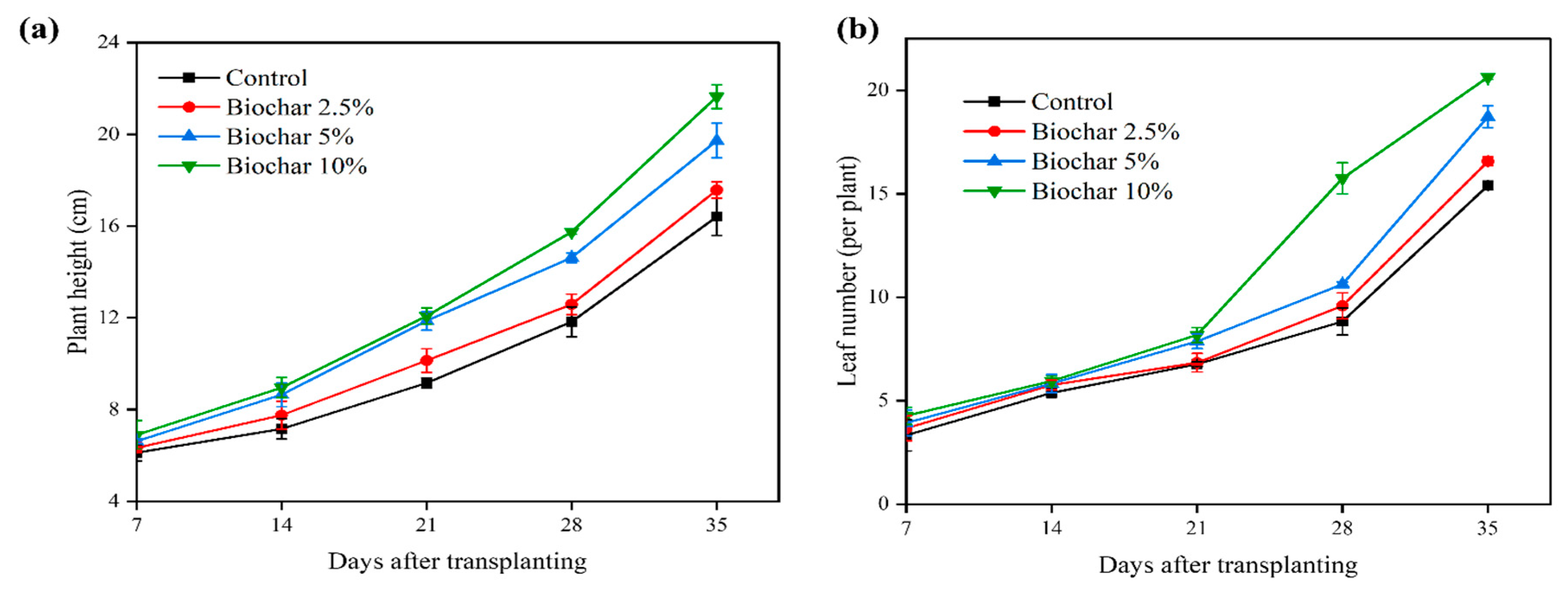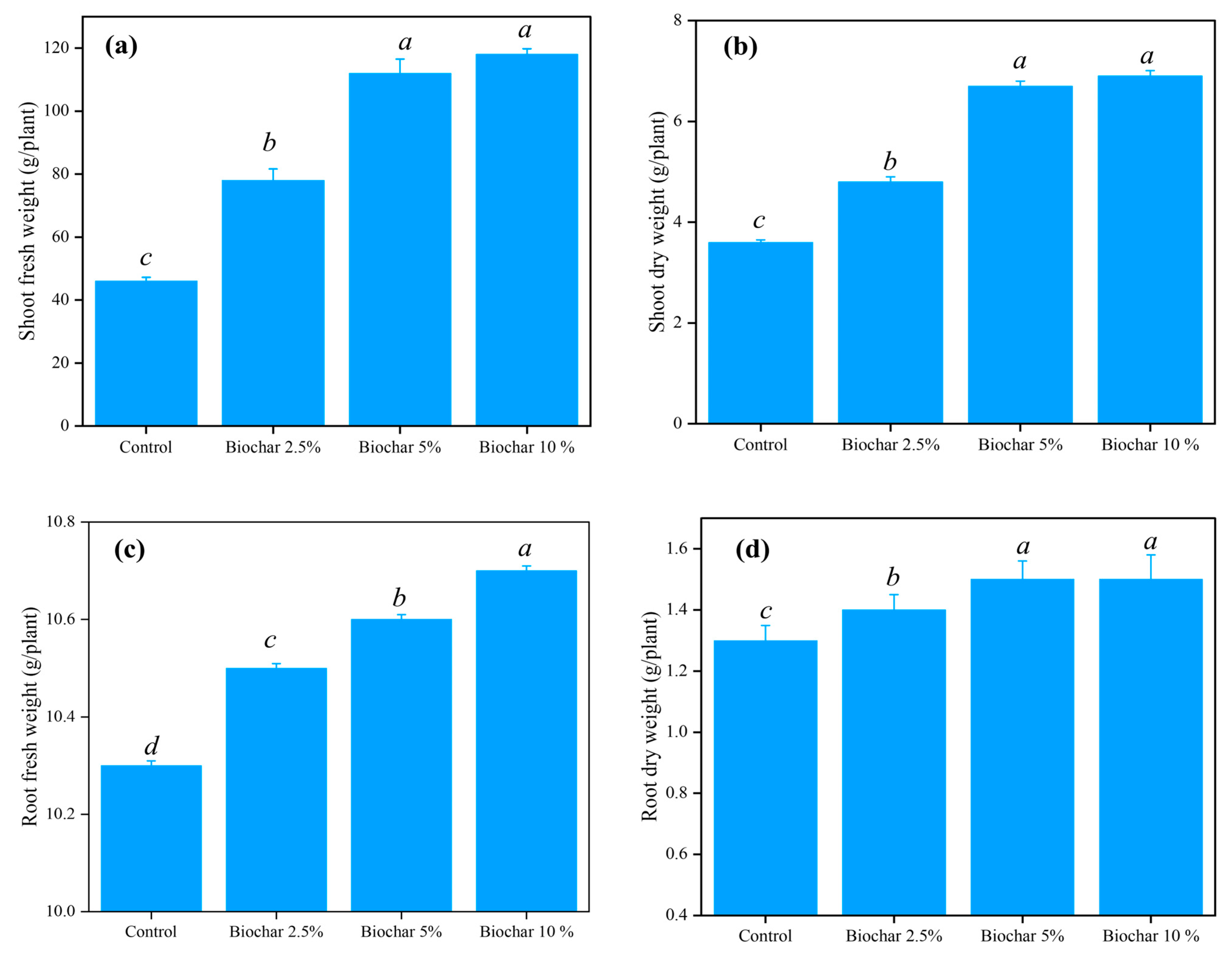Biochar Production from Wastewater Sludge for Application in Sustainable Lettuce Plant Cultivation and Climate Change Mitigation †
Abstract
:1. Introduction
2. Materials and Methods
2.1. Wastewater Sludge and Biochar Production
2.2. Soil Sampling and Analysis
2.3. Experimental Design
2.4. Plant Growth and Quality Investigation
2.5. Statistical Analysis
3. Results and Discussion
3.1. Biochar and Soil Characterization
3.2. Effects of Biochar on Plant Growth Characteristics
3.3. Climate Change Prospects and Economic Feasibility Associated with the Application of Wastewater Sludge-Derived Biochar for Soil Amendment
3.3.1. Climate Change Mitigation
3.3.2. Economic Feasibility
3.4. Sustainable Development Goals (SDGs) Associated with Biochar Application for Soil Amendment
4. Conclusions
Supplementary Materials
Author Contributions
Funding
Institutional Review Board Statement
Informed Consent Statement
Data Availability Statement
Acknowledgments
Conflicts of Interest
References
- Das, S.K.; Ghosh, G.K.; Avasthe, R. Application of Biochar in Agriculture and Environment, and Its Safety Issues. Biomass Convers. Biorefinery 2020, 13, 1359–1369. [Google Scholar] [CrossRef]
- Dadebo, D.; Nasr, M.; Fujii, M.; Ibrahim, M.G. Bio-Coagulation Using Cicer Arietinum Combined with Pyrolyzed Residual Sludge-Based Adsorption for Carwash Wastewater Treatment: A Techno-Economic and Sustainable Approach. J. Water Process Eng. 2022, 49, 103063. [Google Scholar] [CrossRef]
- Woolf, D.; Amonette, J.E.; Street-Perrott, F.A.; Lehmann, J.; Joseph, S. Sustainable Biochar to Mitigate Global Climate Change. Nat. Commun. 2010, 1, 56. [Google Scholar] [CrossRef] [PubMed]
- Yoo, J.H.; Luyima, D.; Lee, J.H.; Park, S.Y.; Yang, J.W.; An, J.Y.; Yun, Y.U.; Oh, T.K. Effects of Brewer’s Spent Grain Biochar on the Growth and Quality of Leaf Lettuce (Lactuca Sativa L. Var. Crispa.). Appl. Biol. Chem. 2021, 64, 10. [Google Scholar] [CrossRef]
- Neogi, S.; Sharma, V.; Khan, N.; Chaurasia, D.; Ahmad, A.; Chauhan, S.; Singh, A.; You, S.; Pandey, A.; Bhargava, P.C. Sustainable Biochar: A Facile Strategy for Soil and Environmental Restoration, Energygeneration, Mitigation of Global Climate Change and Circular Bioeconomy. Chemosphere 2022, 293, 133474. [Google Scholar] [CrossRef] [PubMed]
- Carter, S.; Shackley, S.; Sohi, S.; Suy, T.B.; Haefele, S. The Impact of Biochar Application on Soil Properties and Plant Growth of Pot Grown Lettuce (Lactuca Sativa) and Cabbage (Brassica chinensis). Agronomy 2013, 3, 404–418. [Google Scholar] [CrossRef]
- ASTM. Standard Test Methods for Moisture, Ash, and Organic Matter of Peat and Other Organic Soils. In Annual Book of ASTM Standards; ASTM International: West Conshohocken, PA, USA, 1993; No. 6–9 April. [Google Scholar]
- Trupiano, D.; Cocozza, C.; Baronti, S.; Amendola, C.; Vaccari, F.P.; Lustrato, G.; Di Lonardo, S.; Fantasma, F.; Tognetti, R.; Scippa, G.S. The Effects of Biochar and Its Combination with Compost on Lettuce (Lactuca Sativa L.) Growth, Soil Properties, and Soil Microbial Activity and Abundance. Int. J. Agron. 2017, 2017, 3158207. [Google Scholar] [CrossRef]
- González-Pernas, F.M.; Grajera-Antolín, C.; García-Cámara, O.; González-Lucas, M.; Martín, M.T.; González-Egido, S.; Aguirre, J.L. Effects of Biochar on Biointensive Horticultural Crops and Its Economic Viability in the Mediterranean Climate. Energies 2022, 15, 3407. [Google Scholar] [CrossRef]
- Filiberto, D.M.; Gaunt, J.L. Practicality of Biochar Additions to Enhance Soil and Crop Productivity. Agric. 2013, 3, 715–725. [Google Scholar] [CrossRef]
- Dadebo, D.; Ibrahim, M.G.; Fujii, M.; Nasr, M. Transition towards Sustainable Carwash Wastewater Management: Trends and Enabling Technologies at Global Scale. Sustainability 2022, 14, 5652. [Google Scholar] [CrossRef]


| Biochar Sample | Soil Sample | |||
|---|---|---|---|---|
| Parameter | Value | Parameter | Value | |
| pH (1:10 H2O) | 7.8 | Texture (%) | Sand | 70 |
| EC (dS/m) | 0.72 | Silt | 12 | |
| N-total (g/kg) | 7.6 ± 0.3 | Clay | 18 | |
| P-total (g/kg) | 14.1 ± 2.4 | Water content (wt%) | 20.8 | |
| C-total (g/kg) | 766.8 ± 11.5 | pH (1:5 H2O) | 6.2 | |
| Alkalinity (%CaCO3) | 15.3 ± 0.9 | EC (dS/m) | 0.2 | |
| CEC (cmol/kg) | 19.4 ± 1.3 | Ash content (%) | 90.8 | |
| Organic matter (%) | 1.1 | |||
| N-total (g/kg) | 1.5 ± 0.1 | |||
| P-total (g/kg) | 0.3 ± 0.0 | |||
| C-total (g/kg) | 10.2 ± 0.8 | |||
| CEC (cmol/kg) | 29.8 ± 1.8 |
| Application Rate (%) | CO2 fixation Value (EUR/ha) | Crop Income + CO2 Value (EUR/ha) | Biochar Cost (EUR/ha) | Payback Period (Years) |
|---|---|---|---|---|
| 2.5 | 185.4 | 875.91 | 800 | 0.91 |
| 5 | 370.8 | 1795.18 | 1600 | 0.89 |
| 10 | 741.6 | 2295.79 | 3200 | 1.39 |
Disclaimer/Publisher’s Note: The statements, opinions and data contained in all publications are solely those of the individual author(s) and contributor(s) and not of MDPI and/or the editor(s). MDPI and/or the editor(s) disclaim responsibility for any injury to people or property resulting from any ideas, methods, instructions or products referred to in the content. |
© 2023 by the authors. Licensee MDPI, Basel, Switzerland. This article is an open access article distributed under the terms and conditions of the Creative Commons Attribution (CC BY) license (https://creativecommons.org/licenses/by/4.0/).
Share and Cite
Dadebo, D.; Ibrahim, M.G.; Fujii, M.; Nasr, M. Biochar Production from Wastewater Sludge for Application in Sustainable Lettuce Plant Cultivation and Climate Change Mitigation. Biol. Life Sci. Forum 2024, 30, 10. https://doi.org/10.3390/IOCAG2023-15934
Dadebo D, Ibrahim MG, Fujii M, Nasr M. Biochar Production from Wastewater Sludge for Application in Sustainable Lettuce Plant Cultivation and Climate Change Mitigation. Biology and Life Sciences Forum. 2024; 30(1):10. https://doi.org/10.3390/IOCAG2023-15934
Chicago/Turabian StyleDadebo, Derrick, Mona G. Ibrahim, Manabu Fujii, and Mahmoud Nasr. 2024. "Biochar Production from Wastewater Sludge for Application in Sustainable Lettuce Plant Cultivation and Climate Change Mitigation" Biology and Life Sciences Forum 30, no. 1: 10. https://doi.org/10.3390/IOCAG2023-15934
APA StyleDadebo, D., Ibrahim, M. G., Fujii, M., & Nasr, M. (2024). Biochar Production from Wastewater Sludge for Application in Sustainable Lettuce Plant Cultivation and Climate Change Mitigation. Biology and Life Sciences Forum, 30(1), 10. https://doi.org/10.3390/IOCAG2023-15934









